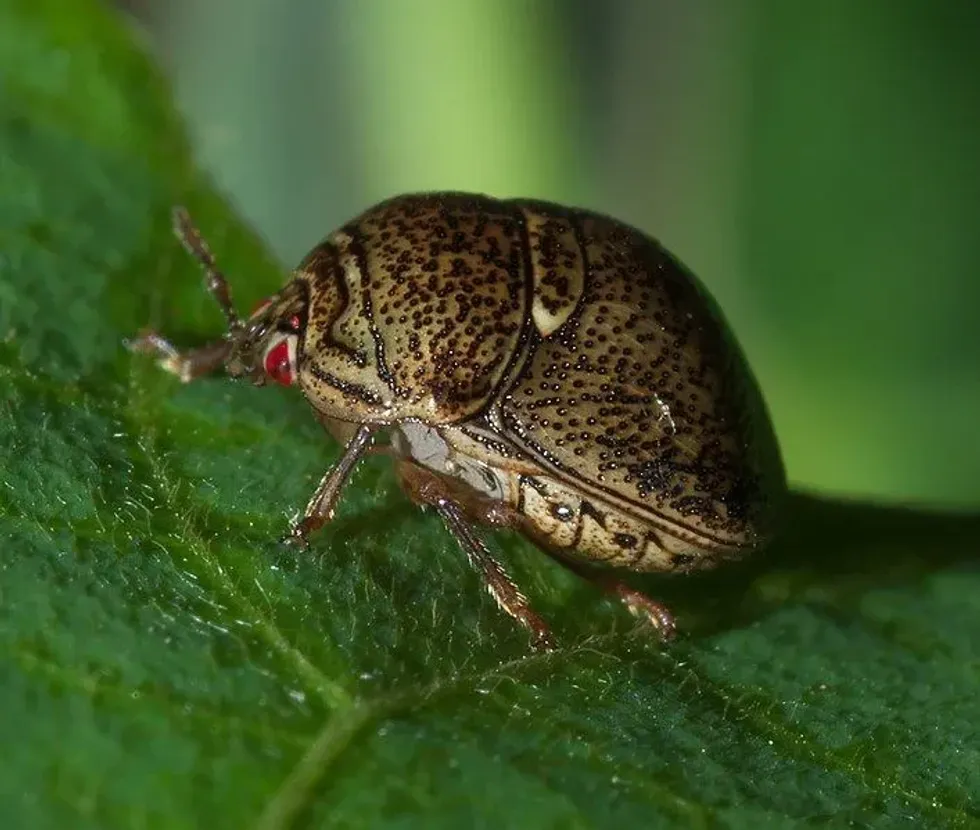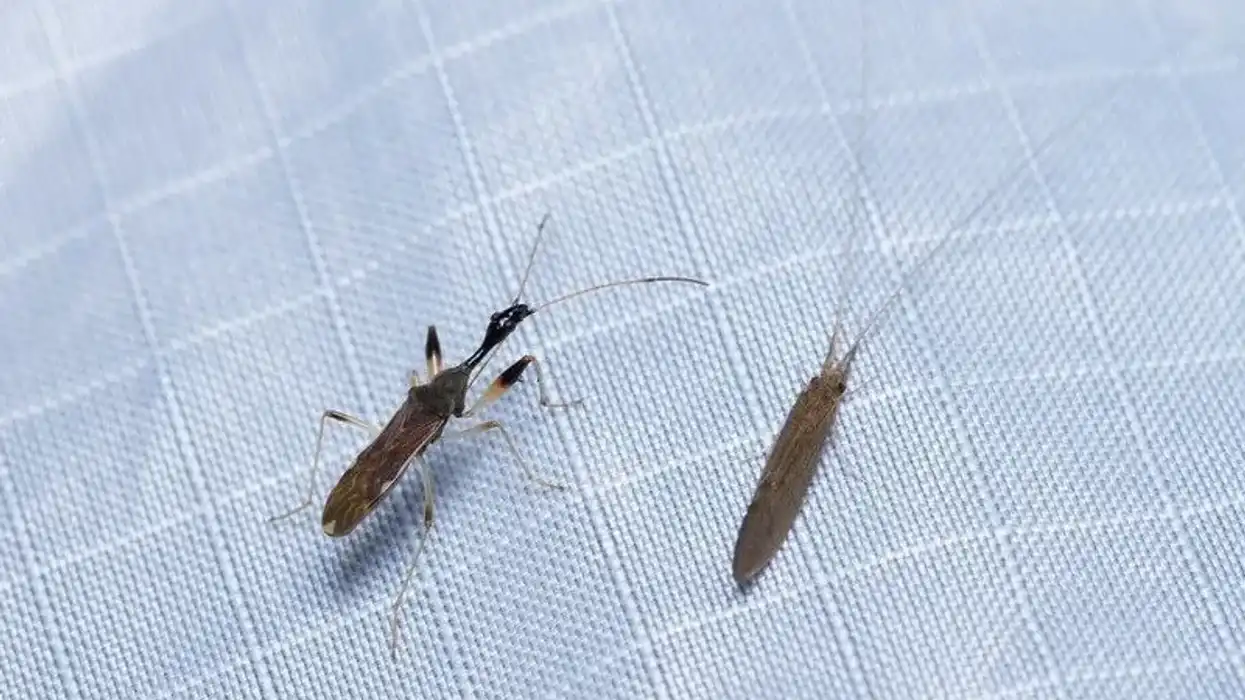The Kudzu bug (Megacopta cribraria) is an agricultural pest of beans and other legumes. Nicknamed as 'globular stink bug', this true bug has many other famous names such as lablab bug, bean plataspid, and kudzu bug.
The Kudzu bug originated in China and India and was first reported in the United States in October 2009. It was believed to be on a plane from Asia to Atlanta, quickly spreading across Georgia, South Carolina, and North Carolina.
Kudzu bugs can be beneficial if they feed on Kudzu alone instead of other Kudzu bug infestation of soybeans plants. They are not harmful to people or houseplants but can become a problem when they enter houses.
Once they arrive, these olive-green bugs can be easily identified because of their large populations and the unpleasant odors and stains they leave behind.
As they are relatively new to the United States, there is no specific method of pest control to keep them away, but prevention is better than looking for Kudzu bug treatment to get rid of them as it could be a long, troubling process.
If you like reading about the Kudzu bug, do check out the wheel bug and giant water bug for more interesting content.
Kudzu Bug Interesting Facts
What type of animal is a kudzu bug?
The Kudzu bug parasite is an insect from the family Plataspidae with the scientific name Megacopta cribraria. They are first spotted in Georgia, the United States, in 2009.
What class of animal does a kudzu bug belong to?
This pest, soybean, and Kudzu bug (invasive species) from the class Insecta.
How many kudzu bugs are there in the world?
An exact figure of their population globally could not be determined. Aggregations are confined to Asia, Europe, and Africa before they were spotted in North America, particularly in Georgia and South Carolina, for the first time in October 2009.
Earlier to this, these pests are not known to be in Western Hemisphere. In the United States, these pests complete two generations per year.
Where does a kudzu bug live?
Native to China and India, these invasive pests have been rapidly spreading through the US states of Georgia, North Carolina, South Carolina, Florida, Tennessee, Alabama, Louisiana, and Mississippi. These are popular soybean-producing states, and this is now a significant threat to many counties across Georgia and then through South Carolina.
What is a kudzu bug's habitat?
This agricultural pest emerges in large numbers in the spring after overwintering in garden debris, tree bark, cracks, or the gaps around doorframes of homes. The Kudzu bug habitat is on kudzu plants, soybean fields, and near residential areas. They are attracted to light-colored surfaces, white cars, white house siding, and white shirts.
Who do kudzu bugs live with?
Large numbers of Kudzu bugs are disturbed, and they live by flying in big groups. If the Kudzu plantation becomes too crowded, these bugs leave for soybeans, Kudzu's close relative.
How long does a kudzu bug live?
The Kudzu bug life cycle of an adult Kudzu ranges from 23-77 days attributed to location, temperature, and nutrition.
How do they reproduce?
Kudzu bugs reproduce on host plants, specifically on early maturing or early-planted soybean farms. The adult females lay egg masses in two side-by-side rows on the underside of the host plant resulting in nymphs that go through five stages becoming the first-generation Kudzu adults.
These five stages take a time of six to eight weeks. Under the Kudzu bug eggs, capsules of endosymbiotic bacteria are also left by the female. This bacteria needs to be consumed by Nymphs soon after hatching to lead a normal life cycle, and then they start feeding on soybean plants.
This first generation of bugs produces offspring that will become second-generation. Then they move away from their hosts to go into overwintering sites.
What is their conservation status?
The conservation status of these bugs is currently not evaluated. As these pests are very new to the United States, there are no records of them, and neither is there any established way to treat them. However, currently, plenty of them are threatening humans and farms in some regions.
Kudzu Bug Fun Facts
What do kudzu bugs look like?
The Kudzu bug has a beetle-like olive-green structure with brown speckles in appearance. It is hard to mistake this pest for anything else. They have a unique, ovoid shape that has wider bottom than at the top and a plate on their back. Like other true bugs, this too uses piercing-sucking mouthparts to eat sap with a beak-like mouth.
How cute are they?
They have a round shape than an elliptical or triangular shape standard among shield bugs. They are wider than other stink bugs, which makes them easily recognizable. They are small which could make them cute, but they are smelly pests.
How do they communicate?
These bugs start as small infestations and can soon turn into catastrophic proportions. They release a pheromone to attract other kudzu bugs to the area to communicate.
How big is a kudzu bug?
An adult Kudzu stinks bug (Megacopta cribraria) can be a sixth to a quarter-inch (3.5-6 mm) in length, close to the size of a lady beetle.
How fast can a kudzu bug move?
Kudzu bug movements can quickly replace the dead bugs and fly from one site to another, although their exact speed could not be tracked.
How much does a kudzu bug weigh?
These bugs are so minor in size with insignificant weight for an individual bug. They also gather in large populations in a given area.
What are the male and female names of the species?
There are no specific names for adults, but there can be some physical differences between male and female adults. Both have broad pale areas on their sides; however, in males, they are restricted to the exoskeleton below the legs. Also, females are characterized by distinct V-shaped suture terminal sternites while rounded males.
What would you call a baby kudzu bug?
The younger Kudzu bugs are called nymphs; they hatch from the eggs. They resemble adult bugs when they are born, unlike a larva. They will change patterns, and colors, shed their exoskeleton several times, and go through several developmental stages before attaining sexual maturity. Nymphs look smaller at an immature stage and can be very hairy.
What do they eat?
Kudzu bugs extensively feed on kudzu patches and other legume hosts, including soybean plants. These insects feed and lay eggs on Kudzu and soybeans; Nymphs also start feeding on these plants as soon as they are born.
These insects use piercing to suck foliage, nutrients, and moisture from the soybean plant, creating severe damage to the crop. Alternatively, these bugs also feed on peas, wisteria, peanuts, and garden beans.
Are they poisonous?
These invasive insects do not bite people but only feed on plants. They are not dangerous in the health sense but can be a major nuisance. They are considered bad because they keep moving across the country, troubling homeowners and farmers alike. However, when crushed, Kudzu bugs can stain fabrics and cause skin irritation.
Would they make a good pet?
As evidence suggests, this difficult-to-control pest can cause extensive damage of millions of dollars to crops and trouble humans in residences and office buildings. These cannot be kept as pets as they emit foul odors and skin irritations when disturbed or crushed.
Did you know...
Ever wondered when and where you could find these insects? These are most noticeable twice a year - in early fall and early spring after their winter hibernation to congregate on sun-exposed surfaces to keep themselves warm.
In large numbers, Kudzu bugs are known to swarm houses, love cracks and crevices, and spaces around windows to stay for the winters. If they are indoors, they leave behind stains and foul odors.
For pest control, never touch them or crush them to get rid of them as their secretions could become a nuisance.
Instead, use a shop vacuum rather than a conventional vacuum to capture this pest, as the odor may linger around for some time.
Another way to deal with these bugs is to put some soapy water in a vacuum (a couple of tablespoons of dish soap per gallon) which will kill the bugs. A combination of surfactants, and 43% glyphosate herbicide is another proven method for Kudzu bug control outside the house and surrounding areas.
There are also some generalist predator bugs like lady beetles, damsel bugs, green lacewings, and big eye bugs that will attack kudzu bug nymphs; this can help in wiping out Kudzu bugs.
Why does the kudzu bug stink?
Famously known as 'stink bugs', these insects leave a strong chemical with a fetid odor on everything when disturbed or squashed. The Kudzu bug scent becomes a significant problem and annoyance within a household if there are many bugs gathered in the same place.
Why does the kudzu bug burn skin?
Kudzu bugs have a chemical defense at alarming levels. Although the Kudzu bug bite is not harmful to humans, its secretion will leave welts and burn-like marks when they come into contact with your skin.
Stay away from crushing to kill the bugs to avoid allergic reactions such as hives, rashes, and others, along with the foul odor and yellow-orange stains on the skin, walls, and other fabrics.
Here at Kidadl, we have carefully created lots of interesting family-friendly animal facts for everyone to discover! Learn more about some other arthropods, including the ambush bug or green stink bug.
You can even occupy yourself at home by drawing one on our Kudzu bug coloring pages.










